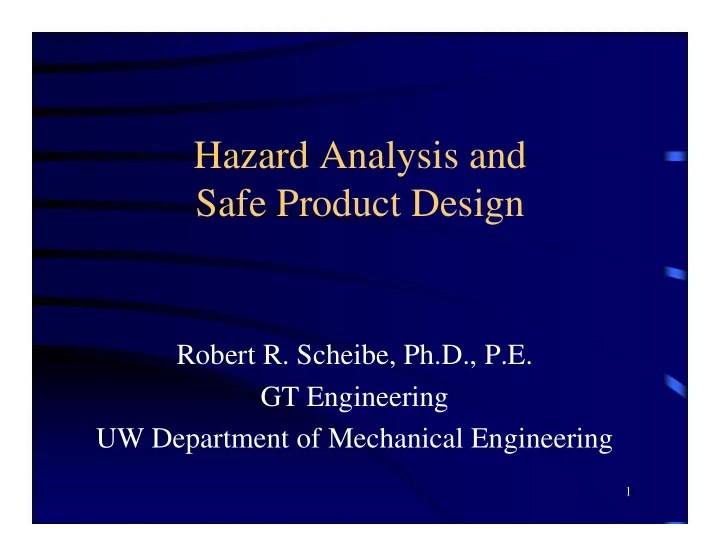

Hazard Analysis and Safe Product Design Robert R. Scheibe, Ph.D., P.E. GT Engineering UW Department of Mechanical Engineering 1
Steps to Consider for Safe Design • Determine scope of the product’s use • Identify the environment product will be used in • Describe the user population • Determine all possible hazards • Determine the probability of certain hazards • Determine the seriousness of possible injury/loss 2 Weinstein, 1978
Steps to Consider, cont. • Postulate alternative design features to mitigate or eliminate hazards (incl. warnings, instructions) • Determine whether alternative design introduces new hazards (incl. warnings, instructions) • Investigate similar products or environments Weinstein, 1978 3
Steps to consider, cont. • Determine cost of alternative design • Determine whether warnings or instructions will be followed by the user (i.e., test them) Weinstein, 1978 4
Hazard Analysis Techniques • Gross-hazards analysis – Done early in design process – Considers overall performance rather than individual components • Classification of hazards – Identifies types of hazards from above – Displays them according to severity Brown, 1991 5
Hazard Analysis Techniques, cont Failure mode and mechanism analysis • Modes • Mechanisms – Plastic collapse – Force/displacement – Excessive deformation – Time (history of initiation or occurrence) – Fatigue – Dimensions – Instability (elastic or inelastic) – Temperature – Brittle Failure – Environment (chemical or physical) – Creep – Material State – Corrosion Hodge and Phillip, 1971 6
Hazard Analysis Techniques, cont • Reliability-risk analysis – Uses statistical data to assess confidence levels and probability of failure • Fault tree analysis – Outlines possible sequences of events leading to an incident • Energy release analysis – Determines energy release in catastrophic event Brown, 1991 7
Hazard Analysis Techniques, cont • Catastrophic analysis – Identifies modes of failure that would create a catastrophic event • Systems analysis – Reveals interfaces and interrelationships between systems • Maintenance hazards analysis – Evaluates performance of maintenance procedures and whether such actions create new hazards Brown, 1991 8
Hazard Analysis Techniques, cont • Human factors analysis – Defines skills needed to operate and maintain systems – Evaluates role human capability and error Brown, 1991 9
Fault Tree Analysis • A logic event diagram showing symbolic representation of the necessary and sufficient subsystem failures needed to result in an undesired event 10
Fault Tree Analysis • Most important step: clearly defining the top undesired event 11
12 Fault Tree Symbology
13 Fault Tree Symbology, cont.
14
15
16 Example: Fire
17 Example: no house heat
Fault Tree Analysis • Advantages – Formalized, systematic deductive analysis approach – Forces thought about possible product hazards – Results in clear graphic record of the process – Readily identifies logical causes of accidents – Can be evaluated qualitatively or quantitatively – Useful in evaluation of design or procedural alternatives – Identifies areas for detailed evaluation by other techniques 18
Fault Tree Analysis • Limitations – Requires thorough understanding of system and its operation in normal and abnormal states – No formalized way to ensure consideration of human factors – Quantification is difficult 19
20 End
Recommend
More recommend